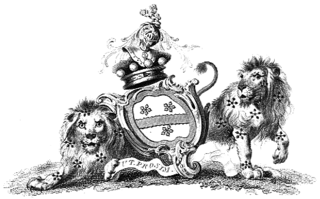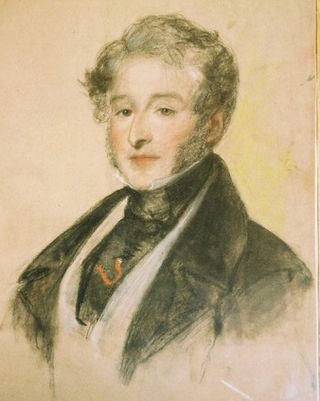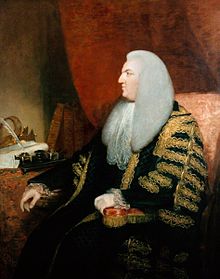
Earl of Carlisle is a title that has been created three times in the Peerage of England.

Viscount Falmouth is a title that has been created twice, first in the Peerage of England, and then in the Peerage of Great Britain. The first creation came in the Peerage of England in 1674 for George FitzRoy, an illegitimate son of King Charles II by Barbara Villiers. He was created Earl of Northumberland at the same time and in 1683 he was made Duke of Northumberland. However, he left no heirs, so the titles became extinct at his death in 1716.

Lord Elibank, of Ettrick Forest in the County of Selkirk, is a title in the Peerage of Scotland. It was created in 1643 for Sir Patrick Murray, 1st Baronet, with remainder to his heirs male whatsoever. He had already been created a Baronet, of Elibank, in the Baronetage of Nova Scotia in 1628. His great-great-grandson, the fifth Lord, was an author and economist. He was succeeded by his younger brother, the sixth Lord, who was an admiral in the Royal Navy. On his death the titles passed to his nephew, the seventh Lord. He represented Peeblesshire in the House of Commons and also served as Lord Lieutenant of Peeblesshire.
Viscount Molesworth, of Swords in the County of Dublin, is a title in the Peerage of Ireland. It was created in 1716 for Robert Molesworth. He was made Lord Molesworth, Baron of Philipstown, of King's County, at the same time, also in the Peerage of Ireland. Molesworth had been invested as member of the Irish Privy Council in 1697, represented Camelford, Lostwithiel, East Retford and Mitchell in the British House of Commons and served as British Ambassador to Denmark. His elder son, the second Viscount, notably served as Ambassador to the Kingdom of Sardinia, the Grand Duchy of Tuscany and the Republic of Venice. He was succeeded by his younger brother, the third Viscount. He was a Field Marshal in the Army. On the death of his son, the fourth Viscount, this line of the family failed, and the titles passed to the latter's first cousin, the fifth Viscount. He was the eldest son of the Hon. William Molesworth, third son of the first Viscount. His son, the sixth Viscount, was a Major-General in the Army, who was lost in the wreck of Arniston. On his death, this line of the family also failed and the titles were inherited by his second cousin, the seventh Viscount. He was the eldest son of Richard, third son of the Hon. William Molesworth, third son of the first Viscount. He was succeeded by his nephew, the eighth Viscount. As of 2010, the titles are held by the latter's great-grandson, the twelfth Viscount, who succeeded his father in 1997.

Viscount Gage, of Castle Island in the County of Kerry of the Kingdom of Ireland, is a title in the Peerage of Ireland. It was created in 1720 for Thomas Gage, along with the subsidiary title of Baron Gage, of Castlebar in the County of Mayo, also in the Peerage of Ireland. In 1744 he also succeeded his cousin as eighth Baronet, of Firle Place. The titles remain united. The Gage family descends from John Gage, who was created a baronet, of Firle Place in the County of Sussex, in the Baronetage of England on 26 March 1622. His great-grandson, the seventh Baronet, represented Seaford in Parliament. He was succeeded by his first cousin, Thomas Gage, 1st Viscount Gage, the eighth Baronet. He sat as a Member of Parliament for Minehead and Tewkesbury and also served as Governor of Barbados. In 1720, 24 years before succeeding in the baronetcy, he was raised to the Peerage of Ireland as Baron Gage and Viscount Gage. His second son was the military commander the Hon. Thomas Gage.

Viscount Bridport is a title that has been created twice, once in the Peerage of Great Britain and once in the Peerage of the United Kingdom. The first creation became extinct in 1814, while the second creation is still extant.
Viscount Colville of Culross, in the Scottish County of Fife, is a title in the Peerage of the United Kingdom. It was created on 15 July 1902 for the politician and courtier, Charles Colville, 10th Lord Colville of Culross. He had already been created Baron Colville of Culross, in the County of Fife, in 1885, also in the Peerage of the United Kingdom. As of 2018, the titles are held by his great-great-grandson, the fifth Viscount, who succeeded his father in 2010. The fourth Viscount was a judge and politician. Lord Colville of Culross was one of the ninety elected hereditary peers that remained in the House of Lords after the passing of the House of Lords Act 1999, and sat as a crossbencher.

Baron Churchill, of Wychwood in the County of Oxford, is a title in the Peerage of the United Kingdom and held by a branch of the Spencer family. It was created in 1815 for Lord Francis Spencer, younger son of the 4th Duke of Marlborough. He had previously represented Oxfordshire in Parliament.

Viscount Scarsdale, of Scarsdale in Derbyshire, is a title in the Peerage of the United Kingdom. It was created in 1911 for the prominent Conservative politician and former Viceroy of India George Curzon, 1st Baron Curzon of Kedleston, who was created Earl Curzon of Kedleston at the same time and was later made Marquess Curzon of Kedleston.

Viscount Devonport, of Wittington in the County of Buckingham, is a title in the Peerage of the United Kingdom. It was created on 22 June 1917 for the Liberal politician and former Member of Parliament for Devonport, Hudson Kearley, 1st Baron Devonport. He had already been created a Baronet, of Wittington in the Parish of Medmenham in the County of Buckingham on 22 July 1908, and Baron Devonport, of Wittington in the County of Buckingham, on 15 July 1910. As of 2017 the titles are held by his grandson, the third Viscount, who succeeded his father in 1973.

Baron Foley is a title that has been created twice in the Peerage of Great Britain, both times for members of the same family.

Baron Lilford, of Lilford in the County of Northampton, is a title in the Peerage of Great Britain. It was created in 1797 for Thomas Powys, who had previously represented Northamptonshire in the House of Commons. His grandson, the third Baron, served as a Lord-in-waiting from 1837 to 1841 in the Whig administration of Lord Melbourne. He was succeeded by his son, the fourth Baron, an ornithologist.

Baron Rodney, of Rodney Stoke in the County of Somerset, is a title in the Peerage of Great Britain. It was created in 1782 for the naval commander Sir George Brydges Rodney, 1st Baronet. He had previously been created a Baronet, of Alresford in the County of Southampton, in the Baronetage of Great Britain on 22 January 1764. His son, the second Baron, represented Northampton in Parliament. He was succeeded by his eldest son, the third Baron. He served as Lord Lieutenant of Radnorshire. His younger brother, the fourth Baron, assumed by Royal licence the additional surname of Harley in 1804. On his death the titles passed to his younger brother, the fifth Baron. He was Rector of Elmley in Kent. He was succeeded by his nephew, the sixth Baron. He was the son of Captain the Hon. Robert Rodney, fourth son of the second Baron. The sixth Baron's great-grandson, the ninth Baron, was an active member of the House of Lords and served as a Delegate to the Council of Europe and the Western European Union. As of 2011 the titles are held by the latter's grandson, the eleventh Baron, who succeeded in 2011.

Baron Dinevor, of Dinevor in the County of Carmarthen, is a title in the Peerage of Great Britain. It was created on 17 October 1780 for William Talbot, 1st Earl Talbot, with remainder to his daughter, Lady Cecil, wife of George Rice, a member of a prominent Welsh family. On Lord Talbot's death the earldom became extinct because he left no sons to succeed to it, while the barony of Talbot also held by him was inherited by his nephew. The barony of Dynevor passed according to the special remainder to his daughter, the second holder of the title. In 1787 Lady Dynevor assumed by Royal licence the surname of de Cardonnel in lieu of Rice.

Baron Ellenborough, of Ellenborough in the County of Cumberland, is a title in the Peerage of the United Kingdom. It was created on 19 April 1802 for the lawyer, judge and politician Sir Edward Law, Lord Chief Justice of the King's Bench from 1802 to 1818. His son, the second Baron, notably served as Governor-General of India. On 22 October 1844 the second Baron was created Viscount Southam, of Southam in the County of Gloucester, and Earl of Ellenborough, in the County of Cumberland. These titles were also in the Peerage of the United Kingdom. His only son predeceased him and on his death in 1871 the viscountcy and earldom became extinct.

Baron Wrenbury, of Old Castle, Dallington in the County of Sussex, is a title in the Peerage of the United Kingdom. It was created in 1915 for the barrister and judge Sir Henry Buckley. He served as a Judge of the High Court of Justice and as a Lord Justice of Appeal. As of 2014 the title is held by his great-grandson, the fourth Baron, who succeeded his father in 2014. The Hon. Sir Denys Buckley, younger son of the first Baron, was also a Judge of the High Court of Justice and Lord Justice of Appeal.

Baron Coleridge, of Ottery St Mary in the County of Devon, is a title in the Peerage of the United Kingdom. It was created in 1874 for the prominent lawyer, judge and Liberal politician Sir John Coleridge. He served as Lord Chief Justice of England from 1880 to 1894. His son, the second Baron, represented Attercliffe in the House of Commons and served as a Judge of the High Court of Justice. As of 2010 the title is held by the latter's great-grandson, the fifth Baron, who succeeded in 1984.
Baron Crawshaw, of Crawshaw in the County Palatine of Lancaster and of Whatton in the County of Leicester is a title in the Peerage of the United Kingdom. It was created on 25 August 1892 for Sir Thomas Brooks, 1st Baronet. He notably served as High Sheriff of Lancashire in 1884. Brooks had already been created a baronet in the Baronetage of the United Kingdom, of Crawshaw Hall and Whatton House, on 9 February 1891. As of 2013 the titles are held by his great-grandson, the fifth Baron, who succeeded his elder brother in 1997.

Baron Ravensdale, of Ravensdale in the County of Derby, is a title in the Peerage of the United Kingdom. It was created in 1911 for the Conservative politician George Curzon, 1st Baron Curzon, of Kedleston, who had previously served as Viceroy of India.

Earl of Arran is a title in the Peerage of Ireland. It is not to be confused with the title Earl of Arran in the Peerage of Scotland. The two titles refer to different places: the Aran Islands in Ireland, and the Isle of Arran in Scotland. The Irish earldom is held by the Gore family. The Scottish earldom is a separate title, held as a subsidiary title of the Duke of Hamilton.
















